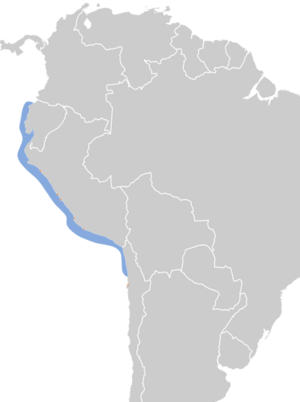Peruvian tern facts for kids
Quick facts for kids Peruvian tern |
|
|---|---|
 |
|
| Conservation status | |
| Scientific classification | |
| Genus: |
Sternula
|
| Species: |
lorata
|
 |
|
| Synonyms | |
|
Sterna lorata Philippi & Landbeck, 1861 |
|
The Peruvian tern (Sternula lorata) is a small tern bird. It belongs to the Laridae family. You can find it in northern Chile, Ecuador, and Peru. This bird lives in hot deserts, on sandy beaches, and near salty coastal lagoons. Sadly, its home is shrinking, which puts the bird at risk. In Spanish, people call it "charrancito Peruano" or "gaviotín chico."
Contents
What Does the Peruvian Tern Look Like?
The Peruvian tern is a very tiny bird. It is about 24 centimeters (9.4 inches) long. The top part of its head and neck are black. The rest of its head is white. Its back, wings, and tail are gray. The throat, chin, and chest are white. Its belly and sides are light gray. The feathers under its tail are white.
This bird has a yellow beak with a black tip. Its eyes are brown, and its legs are yellowish. The light gray color on its belly helps tell it apart from other small terns. It flies with very fast and special wingbeats. Its call sounds like a sharp "kik" or a harsh "gree." It also makes a series of "kee-ee-eer" notes that go down in pitch.
Where Do Peruvian Terns Live?
This bird lives only along the tropical west coast of South America. Its home stretches from northern and central Ecuador, through Peru, and down to northern Chile. It goes as far south as the Mejillones Peninsula. We are not sure how many terns are in Ecuador. In Peru, we know of four places where they live. They breed behind beaches near wetlands.
In Chile, there are nine known places where they live. All of these are near Mejillones. At these places, the birds nest a little bit inland in the desert. There might be other nesting spots that we haven't found yet. Some places haven't been checked in many years.
What Do Peruvian Terns Eat?
Peruvian terns eat different kinds of fish. They have been seen eating the Peruvian anchoveta (Engraulis ringens). They also eat the Atlantic saury (Scomberesox saurus). Other fish they eat include the Peruvian silverside (Odontesthes regia) and the mote sculpin (Normanichthys crockeri).
Peruvian Tern Reproduction and Life Cycle
Peruvian terns usually breed between August and February. Most of their breeding happens from October to January. Their nests are far apart in small groups. These groups can have up to twenty-five pairs of birds. They often nest near coastal wetlands and lagoons. This is where they find their food.
Some birds nest on beaches and sand dunes. These nests are about 100 to 200 meters (330 to 660 feet) from the high tide line. Other birds nest one or more kilometers (over half a mile) inland on sandy plains. A female tern lays one or two eggs. Both the eggs and the chicks are camouflaged. This helps them hide from danger. After breeding, the birds leave the coast. They might go out to sea. During El Niño years, they also stay away from the shore. They do not try to breed then and probably stay at sea.
Protecting the Peruvian Tern
Experts believe there are only about 1,000 to 2,499 Peruvian terns left. Their numbers seem to be going down. In 2007, it was thought that there were only half as many birds as ten years before. Because there are so few birds and their numbers are dropping, BirdLife International says the bird is an "endangered" species. This means it is at high risk of disappearing forever.
A Chilean bird expert named Jürgen Rottmann leads The Gaviotín Chico Sustainability Foundation. This group has worked with local students, town leaders, and mining companies. Together, they protect the nesting areas of this bird at the Mejillones Peninsula. They protect the birds from stray dogs and other animals that hunt them. These hunters make the problem worse for birds already affected by human actions. Their plans include marking and fencing off nesting sites. They also move predators away and use fake Japanese quail eggs to trick them.


